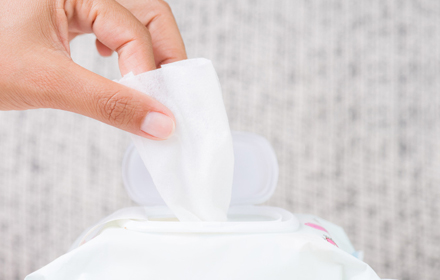Summary: While wet wipes material are a cons...
While
wet wipes material are a consumer necessity, little is known about their composition. While the majority of wipes are made from petroleum-based materials, they are also made from bio-based fibers. The increased use of wet wipes has led to an increase in plastic consumption, which is contributing to environmental pollution. To investigate wet wipes' environmental impact, the current study analyzed the materials composition and final disposal processes of wet wipes in China. It also compared the life cycle environmental effects of petroleum-based and bio-based wipes.Wet wipes contain a variety of chemicals. Aside from water, they may also contain softeners, lotions, or perfume. These substances can be added to wet wipes to help adjust their olfactory and tactile properties.
Wet wipes Selected high-quality cellulose fiber as raw material, processed by special technology. After water and essence, the material is comfortable and soft, and it cares for delicate skin. Wipe does not produce relative slip and cleans skin more effectively.
Selected high-quality cellulose fiber as raw material, processed by special technology. After water and essence, the material is comfortable and soft, and it cares for delicate skin. Wipe does not produce relative slip and cleans skin more effectively.The wipes themselves are usually packaged in a plastic pouch or box dispenser.The composition of wet wipes varies greatly, but a few important factors have been identified. Cellulosic fibers and wood pulps are both biodegradable, but some wipes contain synthetic fibres as well.Wet wipes are a popular household item in many countries and are made of non-woven fabric. Unlike traditional fabrics, which are made by weaving fibers together, non-woven fabrics are created by pressing a mass of separate fibers together. Common non-woven fabrics include polyester, rayon, and cotton.There are several steps in the manufacturing process of wet wipes. The first step is the selection of the raw material. Then the substrate is moistened with a mild cleansing solution.
The fabric is then packaged in thermoformed plastic tubs. Using this method of production, wet wipes can be easily dispensed.The second step involves mixing the ingredients in large batch tanks. These tanks are usually filled with water and may be heated to aid in blending. The different components are added sequentially until the solution is homogeneous. Once the wipe solution is complete, the non-woven fabric is fed into coating machinery. The wipe solution can be added to the fabric in a number of ways. The fabric can be dipped in the solution or sprayed on the fabric using a sprayer.There are many different ingredients in wet wipes, and no two brands are exactly alike. These ingredients are used to clean and disinfect the skin. Some of them are harmless, while others can be harmful. Some of the ingredients that are best avoided are those that are known to cause allergic reactions.
These include benzoic acid, sorbic acid, and levulinic acid. Phenoxyethanol is another common ingredient found in wipes.Some wet wipes contain propylene glycol, which is a chemical solvent that is used to keep the skin moist. The chemical is very similar to glycerin and is used to prevent skin from drying out due to the evaporation of liquid. Propylene glycol is considered a safe ingredient for wet wipes, but it may not be the best choice for sensitive skin.A mild surfactant is essential for baby wipes because it lowers the surface tension. This ingredient also helps keep the wipes fresh. Besides being beneficial for your child's skin, some wipes also have other ingredients that help to prevent irritation. Some wipes contain essential oils. A few wipes may even contain rubbing alcohol.Wet wipes are a big problem for the environment. Not only do they cause tons of waste, but they also contain chemicals and plastics. As the wipes are flushed down the drain, they increase the amount of microplastics in the sewage. These tiny particles can become knotted in sewage pipes, creating serious ecological hazards.
